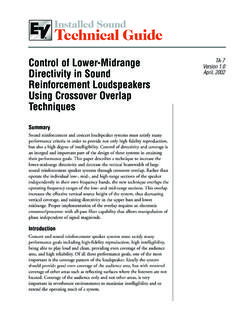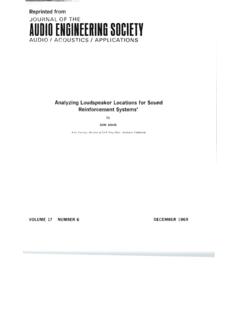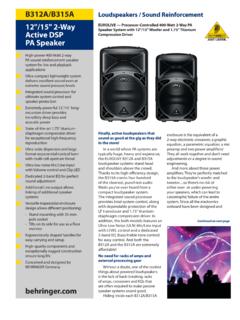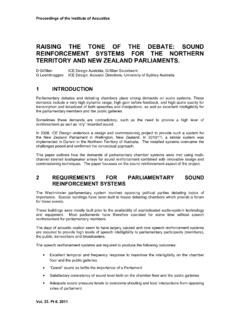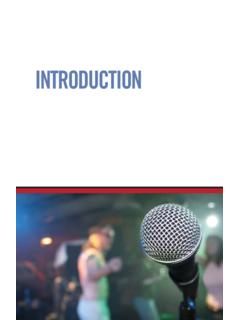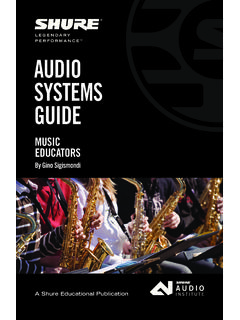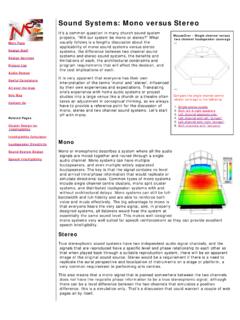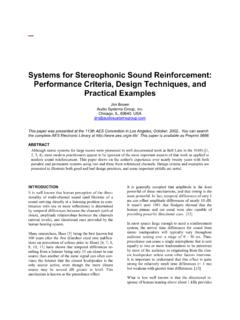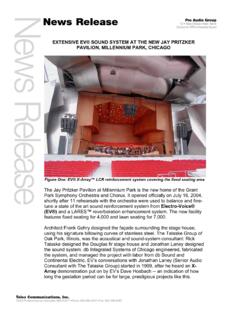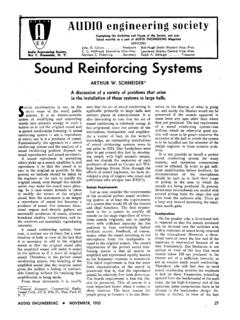Transcription of Live Sound Reinforcement Application Guide for …
1 112 OFPGJun2013 StudioLive AI-Series PAApplicationsGuideTable of Contents1. Overview ..12. StudioLive AI-Series Models ..33. system Configuration Suggestions .. Stereo system .. Mono Cluster with Down-fill .. Plan View LCR Systems .. Vertical Coverage .. Auditorium with Balcony Delays and Front Fill .. Surround and Corporate Theater .. Monitor Systems .. Sub Alignment ..94. Example Hookup Diagram ..10-111. OverviewStudio monitors are designed to accurately reproduce mu-sic across a broad spectrum without signal loss or distortion but they can t handle the SPL demands and other necessities of a live PA speakers can deliver plenty of volume but except for very high-end systems, they can t deliver the extremely clear, accurate Sound one expects in a studio. As a result, a PA speaker that delivers studio-monitor quality has remained an unfulfilled fantasy until fantasy has, at last, become reality, thanks to a partnership between PreSonus and Fulcrum Acoustic s legendary en-gineer David Gunness (formerly of EAW and Electro-Voice).
2 Live Sound Reinforcement Application Guide for PreSonus StudioLive AI-Series LoudspeakersRather than take the usual brute-force approach to PA-speaker design, the team designed a coaxial loudspeaker that would employ Fulcrum s unique DSP-based result is PreSonus Studio-Live AI-series Active Integration Loudspeakers, the first affordable, active PA speaker systems that de-liver studio-monitor accuracy ex-ceptionally clear, coherent Sound while supplying the features and protection systems required to mix a live show that sounds great in a wide variety of venues, with virtually any musical features include wireless and wired control of all setup, tun-ing, and monitoring functions, using an iPad or StudioLive AI series consists of three full-range systems and a subwoofer. All models are self pow-ered and utilize onboard DSP. StudioLive AI speakers have been custom tuned using Fulcrum Acoustics Temporal Equalization algorithms.
3 The internal phase, alignment and FIR filters are not individually user-adjustable; how-ever, each loudspeaker offers dif-ferent contours that adjust these parameters to customize your system for your Application . Custom EQ, delay, and group functions can be applied on top of these contours via the User Preset and can be ad-justed from within SL Control Room for iPad, Mac OS X, and Windows. 231212 OFOFPGPGJun2013 Jun2013 StudioLive AI-Series PAApplicationsStudioLive AI-Series PAApplications StudioLive AI-Series PA Applications GuideStudioLive AI-Series PA Applications GuideThe Active Integration DifferenceStudioLive Active Integration (AI) loudspeakers combine advanced DSP and networkability. The onboard 24-bit, 96 kHz processor operates at 350 MHz and features as-similated USB and 100 Mb Ethernet connections. Because of this, AI loudspeakers can be directly wirelessly remote controlled by iOS devices and OS X or Windows computers when connected to the same wireless router AI products currently run a Linux kernel that allows support for the included USB wireless module, as well enabling the included Ethernet port to connect directly to a standard local area network (LAN).
4 The DSP s speed also allows for an unprecedented amount of dynamics and effects processing. CoActual OnboardEach full-range AI-series loud-speaker is based on an eight-inch CoActual coaxial speaker for high- and mid-frequency reproduction. The aural sensation of transparent Sound that is typical of coaxial sys-tems is, of course, beneficial in mains but is also helpful in proximate ap-plications such as stage monitoring, front-fills, under-balcony fills, and FOH live monitoring. Coaxial speakers offer many benefits in theory; CoAc-tual speakers make benefits a loudspeaker designs gen-erally suffer from the changing rela-tionship between the listener and the speaker ele-ments. A coaxial loudspeaker s response behavior is symmetric in both the horizontal and the vertical axes. This means that whatever re-sponse is observed at a given angle with respect to the axis is the same at that angle in the opposite direction.
5 In other words, the loudspeaker s behavior is "mirrored" about its axis. Another benefit of the CoActual speaker design is that the crossover transition is undetectable (inaudible and immeasurable), not just on axis, but also at other angles. CoActual speakers accomplish this by using time correction to effectively make the acoustic centers of both the mid and HF driver the same that is, by delaying the woofer back to the same plane as the compression signal alignment allows AI-series loudspeakers to produce transient signals with the least possible change in the shape of the waveform. The sounds we wish to reinforce in a Sound system are dominated by transient information. Consonant sounds in speech, per-cussive sounds, and the attack and decay portions of all musical instru-ment sounds are transients. These transients consist of com-plex combinations of many frequen-cies, and the phase relationships of the individual harmonics are a critical part of the characteristic " Sound " of an instrument or voice.
6 Only an opti-mally aligned loudspeaker can repro-duce them is a significant element in sonic transparency, definition, and intelligibility, yet it is very seldom discussed, let alone adequately ad-dressed, in professional Equalization While DSP has long been included in loudspeakers, it has generally been handled as an additional feature, rather than a part of the design of the loudspeaker itself. Designers and engineers typically build the best physical loudspeaker they can and then use DSP filters to improve per-formance and to provide the end-user with some EQ contrast, StudioLive AI-series loudspeakers were designed with Fulcrum Acoustic s TQ Temporal Equalization algorithms from the beginning. TQ provides a fully ad-dressable, fairly large Finite Impulse Response (FIR) filter. This filter al-lows for the implementation of more detailed frequency-response ad-justments; more important, we can implement the precise temporal (time domain) filters that are responsible for the most remarkable TQ benefits.
7 Loudspeakers tuned with TQ pro-vide a crisper stereo image, greater soundstage depth, more separation between the components of a com-plex mix, increased resistance to feedback, more seamless transitions between distributed loudspeakers, and a less fatiguing listening experi-ence at very high AI-Series ModelsThe StudioLive AI-Series offers three 3-way full-range models (312AI, 315AI, and 328AI) as well as an 18" subwoofer (18sAI). Each full-range loudspeaker is phase and time-aligned to form a true 4-way system when paired with an 18sAI subwoofer, with or without the 100 Hz highpass filter engaged. With most 4-way systems, leav-ing frequency content below 100 Hz in the full-range loudspeaker can introduce destructive cancellations with the highest frequencies that are reproduced by the subwoofer. StudioLive AI-series loudspeakers are designed to avoid this problem when combined with an 18sAI sub-woofer.
8 This means that for applications where a frequency overlap at 100 Hz is beneficial, you can achieve bigger bass Sound without any extra effort. For applications that require a more linear frequency response between the subwoofer and full-range content, simply engage the highpass filter on the full-range AI-series dispersion pattern from a single point dispersion pattern from two separate will also readjust the phase and time-alignment to keep it in phase with the 18sAI subwoofer. As a result, you can create the best 4-way system for your Application . The three full-range speakers all have the same high-frequency disper-sion characteristics: 90 H x 60 V. Make sure your design utilizes this pattern to cover the listeners as much as possible, while steering away from reflective surfaces like walls, floors, ceilings, and windows. All models have a maximum SPL greater than 130 3-Way, Triamplified loudspeaker System3-Way, Triamplified loudspeaker System3-Way, Quad-amplified loudspeaker SystemPowered Subwoofer, PortedFrequency Response (-10 dB)50 Hz - 23 kHz46 Hz - 23 kHz54 Hz - 23 kHz29 Hz - 141 HzFrequency Response (-6 dB)56 Hz - 22 kHz52 Hz - 22 kHz59 Hz - 22 kHz32 Hz - 110 HzNominal Coverage (-6 dB)90 x 6090 x 6090 x 60n/aMaximum Peak SPL131 dB131 dB133 dB135 dBCrossover FrequencyLF: (overlapped) 100 Hz - 1 kHz, HF: kHzLF: (overlapped) 100 Hz - 1 kHz, HF.
9 KHzn/aDirectivity Index (DI)10 dB, >500 Hz10 dB, >420 Hz10 dB, >460 Hzn/aDirectivity Factor (Q) , >500 , >420 , >460 Hzn/aTransducer LF Transducer12" ferrite15" ferrite2 x 8" ferrite18" ferriteMF Transducer8" CoActual 8" CoActual 8" CoActual 4"HF " compression " compression " compression drivern/aPlease refer to the PreSonus Rigging Guide for proper installation guidelines for your : Installation of StudioLive AI-series loudspeakers should only be done by a licensed and insured professional. 2. At a glance: StudioLive AI-series loudspeakers451212 OFOFPGPGJun2013 Jun2013 StudioLive AI-Series PAApplications StudioLive AI-Series PA Applications GuideStudioLive AI-Series PA Applications GuideSystem configuration suggestionsThe following pages will demon-strate some system configurations for common rooms. The size and shape of your room and the Application for which it will be used greatly deter-mines how many speakers you will need and how they should be placed.
10 In every situation you should keep in mind two important design factors: your loudspeaker s coverage pattern and half-space full-range StudioLive AI loud-speaker offers offer the same 90 hori-zontal x 60 vertical coverage pattern. Be sure to pay close attention to these angles when using your speakers. Ro-tating the cabinet changes the hori-zontal and vertical coverage. When configured for stereo use, make sure the cabinets are not placed too wide for the room or too far back into the corners. Too wide of a placement will direct too much energy onto the walls and can poten-tially add destructive interference to the room. Adjust the left and right speakers, as well as the toe-in angle, to produce the best stereo image. If a room is very narrow, a mono cluster might be a better you place your loud-speakers, you should be aware of half-space loading.


